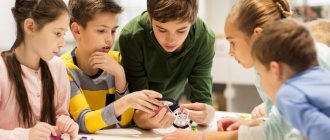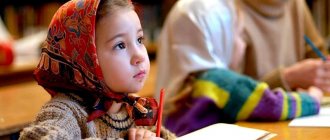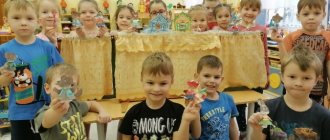Project “Joint creative activity of children and their parents in the educational process”
MUDO Center for Additional Education of Children in Avsyunino
Orekhovo-Zuevsky urban district, Moscow region
Project
“Joint creative activity of children and their parents
in the educational process"
The author of the project is a teacher of additional education
highest qualification category
Kuritsina Elena Konstantinovna
2020
“Joint creative activity of children and their parents
in the educational process"
The key task of modern state policy of the Russian Federation is to ensure the spiritual and moral development and education of the personality of a Russian citizen.
“Spiritual and moral development and education of the individual begins in the family. It is family values, acquired by a child from the first years of life, that are of lasting importance for a person at any age and form the basis of civil behavior in society.”
Parents play a vital role in a child's life. Parental love is the source and guarantee of human well-being, maintaining physical and mental health. That is why the first and main task of parents is to create confidence in the child that he is loved and cared for. Deep, constant psychological contact with parents gives the child the opportunity to feel and realize parental love, affection and care.
The basis for maintaining psychological contact is a sincere interest in everything that happens in a child’s life, sincere curiosity about his childhood, even the most trivial and naive, problems, a desire to understand, a desire to observe all the changes that occur in the soul and consciousness of a growing person. It is necessary to communicate with children from a young age: without communication, without constant concern for arranging common leisure time and common affairs with them, parents will not be interested in their own children.
The main values of educational activities in the system of additional education are the child, his development, childhood as the special life of a child, educational space as an environment conducive to personal development. Therefore, additional education has great potential to help parents establish and maintain psychological contact with the child, spiritual and moral development and education of all participants in the educational process.
One of the forms of interaction between additional education institutions and students’ families is family clubs and workshops. Organized joint creative activity is the inclusion of the parent in the child’s activity. This is a situation in which a child, faced with a certain difficulty, has the opportunity to turn to a parent for help. And the parent gets the opportunity to do the work together with the child. As a result of joint creative activity and common interests, the child and parent reach mutual understanding and become closer to each other.
“Together it’s fun and useful!” (or about the joint creativity of children and parents)
December 22, 2019
Tesh Olga Vladimirovna
teacher
This article talks about the benefits of joint creativity between children and parents, the influence of creative activities on the development of a child’s creative thinking, overcoming the problems of adaptation to kindergarten, as well as the opportunity to satisfy the child’s need for communication and self-affirmation through creative activities.
The child and his parents are in constant contact while the baby grows and gets stronger. He is given maximum attention in the family, his needs and desires are brought to the fore. But as soon as the child is sent to preschool, mom and dad move away, they constantly have no time, they are tired from work, brothers and sisters learn homework, that is, everyone does their own thing. And here is the result: the child feels unnecessary, he is capricious, sick, and does not want to go to kindergarten. Many people think that these are adaptation problems and that the baby will gradually cope with them. However, if parents do not find optimal solutions between their own employment and the child’s need for interaction, then the negative attitude towards the preschool institution will only intensify, and the child will become withdrawn and distrustful.
Psychologists from all over the world assure that joint creative activities between parents and children can solve many problems of adaptation, reduce psychological stress, bring a lot of positive emotions to communication, and teach effective cooperation. In this case, the specific type of joint activity does not matter: it could be drawing, crafts, memorizing poems or playing out fairy tales.
Therefore, creative interaction between parents and child not only compensates for the lack of attention taken away by the crazy rhythm of modern life, but also helps the child express himself, realize his importance in the family, and provides parents with the opportunity to deepen the world and needs of their child. It is especially useful when children of different ages take part in the creative process. Such activities become an excellent platform for teaching mutual assistance, respect for elders, responsibility for younger ones, and also unites the whole family in a common cause.
Regular joint creations lead to the fact that a child turns from an uninitiative helper into a real researcher, a pioneer, he learns to think outside the box. The result of joint creativity is not only the acquisition of experience in this area, but also the well-being of the baby, the joy of communication and pride in the presented result.
At first, when he sees ordinary objects, he will begin to form unique, bold associations, then he will delight his loved ones with an original approach to solving various problems at school or with a creative surprise for his birthday. Subsequently, a child who was constantly trained in childhood will reveal his full creative potential at an older age, will have a lot of ideas and find more and more original ways to implement them.
Thus, if at least once a week (or better yet, more often) you devote time to joint creativity, then the baby will never feel detached and unnecessary, the family will have common interests, and the young creator will definitely prove himself in the future.
Share with friends
Teaching crochet to children writing with their left hand. Design and research activities in Russian language lessons in elementary school
You do not have sufficient rights to add comments
You must be logged in to post comments. If you do not yet have an account on our website, we invite you to register. It will take no more than 5 minutes.
Comments
Zibareva Lyudmila Anatolyevna
08.01.2020 22:08
Olga Vladimirovna, excellent article! Now it is very important to develop the creative potential in children, to give them the opportunity to be self-confident, we, teachers, help them with this. But we must not forget about the role of the family... after all, it often turns out that parents themselves do not know how to play with their children, do not know how to fantasize and create... and the family is the main example for the child. You very accurately noticed and suggested options for joint creativity.
Report to moderator
Ryzhenkina Irina Viktorovna
21.02.2020 07:28
Very informative and relevant article. I agree that joint creativity between children and parents brings great benefits in communication. Thank you very much!
Report to moderator
Joint creativity with children
Addition to the family radically changes life. Young parents, especially mothers, tend to devote all their time to their newborn. Finding a moment for yourself, and even more so for your favorite hobby, becomes an almost impossible task. Even when children grow up and no longer require such careful care, pleasure is postponed until better times. Like, we need to devote more time to children, and not do something of our own. Is it so? Children certainly need your attention, and your hobby can be not a hindrance, but a great opportunity for this!
When you turn one year old, you can already find at least a little time to take up a hobby without detriment to your baby. Children are very susceptible. Your elation, inspiration, emotions that you experience while doing what you love are literally absorbed by small children. If it is natural and habitual for a child to see his mother embroidering or his father working with a jigsaw, then a creative attitude to life will be just as natural and habitual for him.
Children and handicrafts
The benefits of handmade work are obvious. Development of fine motor skills of the hands; nurturing perseverance, patience, attentiveness and similar wonderful qualities; development of creativity, imagination, fantasy, originality - all this is provided by “handmade” classes. And if parents encourage these activities, sincerely support and praise, then the little creator will feel his importance, confidence in his abilities, and the desire to do something else, no less wonderful. Who knows, maybe now the younger generation is taking the first steps in their professional career - famous fashion designers, for example, started with clothes for dolls.
How to introduce creativity?
How to maintain and develop the desire to create beauty with your own hands? The first rule is don’t force it! Believe me, if you are captivated by an interesting activity, the baby will not miss it. Let him become interested, ask a question, ask for help. Give him a piece of your craft, which he will make himself, according to your prompts. Don't forget to give praise when it's deserved. Answer the questions in detail, show what exactly you do. Of course, patience will be required. It is much easier to turn on the TV and distract the inquisitive heir with cartoons or a computer game. But cartoons won’t let him feel your love and won’t add trust to your relationship. Pay close attention to what he likes and offer exactly these types of handmade items. While he is small, it is just a game. But who knows if a real master is growing up next to you, whose products will delight people. Even if he chooses a profession unrelated to creative activity, the ability to think outside the box and get things done will be very useful to him.
What can you do together?
First, the simplest things - drawing, modeling, appliqué. But the younger generation is growing. And you can already master origami. The beauty of paper crafts is captivating, and the scope for imagination is enormous. You can start small and then decorate the room with a stunning arrangement designed and put together by the whole family.
If your daughters liked to sew, then it’s easy to “grow” from simple patchwork dresses for dolls to patchwork. From the same scraps, the whole family can make multi-colored patchwork bedspreads and pillows for the children's room or a stylish rug for the hallway.
Making soft toys, macrame, beading, modeling from polymer clay, knitting and much more - in all these types of handicraft you can start with simple samples and grow into works of art. Dads won't be left out either: skillful work with metal and wood will not leave boys of any age indifferent.
Creation is positive in itself
Pleasure and satisfaction from creating beautiful things can calm you down, drive away depressive thoughts, and lift your spirits. The collective process of creation, especially in the family, has an even greater positive effect. Joint creativity takes family relationships to a new level - communication between creators.
While the mother is weaving beaded beads, her daughter is nearby assembling a bracelet in the same style. While dad is sawing out an openwork lid for a wooden box, his son at the next table is covering the box with varnish. The process of creation gives a special trusting atmosphere to a general conversation, when you can discuss the past day, share a problem, feel the love and support of your closest and dearest people.
This is a great opportunity for busy parents to show how important their children’s opinions are to them and how much they value communication. Agree, this is a tempting alternative to the common situation today, when all family members spend their evenings immersed in gadgets, preferring the virtual world to real interlocutors. How many serious conflicts arise precisely because of misunderstanding, because of the lack of communication habits. This problem is especially relevant for teenagers and their parents. And family handicrafts can be a way to overcome such a crisis.
Fun drawing is the calling of two young artists!
Drawing is a great opportunity to develop both children at once. This activity can maximally develop fine motor skills, a sense of color, the development of imagination and many other aspects of raising children. This activity also tends to delight absolutely all kids. It's hard to find a child who doesn't like drawing.
Under the supervision of a parent, children will be able to fully bring all their ideas to life with the help of markers, pencils and paints. You can even paint the children’s palms, which they will then use with great pleasure to leave prints on sheets of paper, and perhaps even on a large Whatman paper. After all, you can then decorate it with something else and hang it on the wall, creating a unique composition for decorating your home. Children will happily remember the time spent together while looking at it!
Coloring books, of course, give less room for imagination, but they can perfectly teach kids to be neat.
Interesting possibilities are provided by a non-standard approach to the usual process - instead of paper, use crafts made from salt dough, bottles or cups, pebbles, instead of brushes - hands, cotton swabs, potato stamps. Arouse your children's imagination, infect them with a new idea - and enjoy the peace and happiness that comes from creating with children!
MAGAZINE Preschooler.RF
Creative gatherings. Joint creativity brings us closer together!Problem: Family research in a crisis society reveals age-related alienation between parents and children.
Parents are terribly busy with their work. In addition, our children rarely do anything with their own hands, because modern toys, objects and things are arranged as conveniently as possible, but are not effective for the development of motor skills. Instead of communicating with parents, the child “communicates with the TV and computer .
Relevance: This problem is also relevant for our group. Family and kindergarten are two sides of the same educational process, each of which gives the child a certain social experience. And only in merging with each other do they create optimal conditions for a child’s comfortable and easy entry into the big world.
We decided to have creative gatherings
Goal: To involve parents in the creative process, to enrich the relationship between parents and children with the experience of joint creative activity.
Help parents organize joint creative activities in the family.
Tasks: - Create a positive emotional mood, try to bring parents and children closer together.
— Develop the creative abilities of children and adults.
— Organize joint productive activities of children, parents, and teachers.
— Establishing emotional contact.
Type of project: creative and gaming.
Project type: within one age group.
Project participants: children, teacher, parents.
Predicted result:
— Involve parents to participate in the life of the kindergarten and group.
— Form trusting, partnership relationships between the teacher, students and their parents.
— Unleash the creative abilities of children and parents.
Exhibitions - competitions
Nothing brings people closer together than joint creativity, joint search, joint failures and discoveries, when two completely different and strangers suddenly seem to merge into a single whole, begin to feel and understand each other so accurately and so instantly as they have never felt or understood their loved ones.
Yuri Vyazemsky
Joint creativity brings children and parents closer together and helps them get to know each other better.
- And in a situation where children are immersed in the creative process, and parents observe and help and admire the result.
- And in a situation where parents are busy creating, and children watch this process, help and admire!
It’s funny to watch how parents, while helping their children, get so carried away by creativity that they themselves become children: as if for the first time they are learning that you can make interesting crafts from paper, that you can use paints to make the world brighter, and that you can use glue to mold not only paper parts of crafts, but also fingers. Joy, interest, delight - all this is divided in half. And from this it doubles. You become part of his life, not the one where mom and dad worry about whether he has eaten? did you sleep? Did you dress warmly? And the one where the child is the little creator. Where did he come up with it himself! I did it myself! He is already an adult, you have common joys and questions: how to make it better, tastier, more beautiful? how to fasten the parts? how to make a homemade radio work? And many, many other adult questions!
How creativity can benefit your relationship:
- A pleasant pastime (a good alternative to cartoons)
- Joint activities bring both participants closer together and develop
- When the mother is nearby and involved in the process with the child, he feels that he is loved!
- You can become a friend to a child if you are not just present, but do it together
- The child feels that you can be trusted, because... you sincerely show interest in his children's affairs
- Creativity is a good way to cultivate in a child the character trait of finishing something
- Creating something new gives a child a sense of self-worth (I CAN!)
- If you arrange children's crafts in the apartment, hang drawings on mirrors, cabinets, or you have a special shelf for this in the living room (not in the children's room) - this gives the child the feeling that he is respected and accepted as an equal in your family
What are the benefits of creativity for parents? And even for children?
Creativity has enormous healing potential, helping parents cope with stress, depression, understand their emotional state, express their feelings and experiences, feel happy, and make life brighter and richer.
And children see that their parents are passionate about something and enjoy the creative process. That a parent is looking for something new, beautiful, inspiring. That they take something ordinary and make something extraordinary out of it!
After all, we really want our children to grow up to be creative people, capable of thinking outside the box and making non-standard but effective decisions.
By observing a parent in the creative process, helping as much as possible in this matter, the child learns what cannot be taught with words. That creativity is simple and natural. That if there is a situation, then a solution can be found. How could it be otherwise, because my mom (or dad) does this all the time, I see it all the time when she draws, decoupages, makes soap or cooks!
When a child is still very small, an infant for example, he can be compared to a person who sees around him many games and important things, the meaning of which still eludes him. And at first, only the actions of parents and those who closely surround the child show him what the rules of these games are and the meaning of the various events taking place around him. It would seem, what does the creativity of parents have to do with it? After all, young parents cannot breathe from new worries. J It's very simple! If the mother finds a few minutes, naturally without detriment to the baby, to do her favorite embroidery or decoupage, then the baby absorbs it with mother’s milk. It is natural for him that mom (and dad) have a creative streak and a favorite pastime. It’s natural for him that people approach life creatively, but how could it be otherwise, because that’s exactly how my parents live! It’s natural for him to look for creativity to suit his taste and try a lot!
This cannot be taught through conversations, moralizing and lectures.
The child is sure that everything that happens in the family has something to do with him. Nothing escapes the attention of children; it would be an illusion to think that adult life is incomprehensible and uninteresting to them.
Children are unusually receptive to us, our emotional state, and even when immersed in a game or cartoons, they hear and remember everything. And if you allow them to take part in your work themselves, in some form, or simply explain along the way what you are doing now and why, this will definitely not go unnoticed by your child! So don’t torment yourself with the conscience that you are not giving everything for the benefit of your beloved child, but you are also doing your favorite creative work for your own pleasure! This is how you introduce your child to the world of beauty and magic that you can create around you with your own hands!
Let's summarize:
- Encourage your child to be creative
- Arrange creative gatherings together
- Have fun with creativity and sincerely admire the creative process and creations of your baby!
- From early childhood, show your child that creativity is natural and brings pleasure.
- Engage in your creative process next to him, and explain little by little what you are doing and why.
Gradually allow him to participate in what you are doing!
In preschool education, for the successful development of a child, cooperation between parents and teachers plays a huge role, since the success and effectiveness of the educational process in any work with children depends on mutual penetration into each other’s interests.
In our work, we not only cooperate with parents, but also include them in the child’s development process. So the parents of those present at our gatherings, and we call them a “support group” , if necessary, we create decorations to decorate the group and garden for holidays, exhibitions, children turn to them for help. Co-creation strengthens trusting, friendly relationships between children and adults, and also creates a positive attitude towards work. So, in collaboration with children, you can come up with a lot of interesting things for your home or garden.
The use in practice of such a form as joint creativity or co-creation of children and adults does not meet resistance from any side; on the contrary, in the process of co-creation, children learn easily, quickly master the necessary skills, and parents learn to trust the child and give him the opportunity to show independence without worrying about final result.
| Next > |
Joint creativity is a universal recipe for friendship!
Isn't there enough room for children's creativity? You can string beads, sew clothes for numerous dolls and show off your remarkable abilities as a fashion designer. Even an ordinary game of construction may well become a creative outlet for children. After all, it is possible to independently invent and draw up designs for houses, shops, and even build an entire city. The main thing is not to stop children from expressing themselves, and you will be surprised to discover a lot of abilities in them!
Creativity is an important component in the life of any child, and it was created specifically so that two kids have something to do together. Creativity with children will help children learn to communicate not only with each other, but also with others.
How to choose supplies for crafts
You don’t have to look for them, order them, or wait for delivery - and this gives more opportunities for spontaneous creativity.
Plastic lids, scraps, old packaging? Or maybe there will be dried leaves, once collected acorns or chestnuts, intricate twigs? Great! Using unnecessary things for crafts develops imagination, teaches you to see unexpected images, combinations of colors and shapes.
And parents don’t have to put off the “home workshop” until later - when we buy the right paints, when we get to the “Children’s World”, where they sell special kits, when the order arrives by mail...
Finally, it's environmentally friendly!
How to make a fairy tale from plastic corks,
described in detail in Olga Gre's
Joint creative activities with children 3-4 years old
Joint creativity between children and parents brings undoubted benefits. In addition to the development of intelligence, attentiveness, abstract and spatial thinking, memory, fine motor skills, a sense of unity with the parent develops. The baby feels that his mother is next to him and supports all his endeavors. This has a positive effect on the baby’s mental development and provides additional incentive.
Children need to be taught creativity
How to attract children to creativity
It should be remembered that the child has not yet developed this type of joint leisure, so at first he may be a little distant.
For your information! You can’t put pressure on the baby, you need to gently guide him. It is better to demonstrate a desire to work with him in a soft, enticing manner, then he will certainly join his parents.
All actions must be spoken out, the baby must be praised and criticism must be excluded. The child should have his own supplies that he will not be afraid to get dirty; his own creative corner is desirable. It is forbidden to force a child if he is not in the mood.
Advice! Classes will go easier if the parent boasts about their joint achievements to their relatives. Then the baby will be filled with pride and will happily look forward to the next classes.
How to find an individual approach to your baby
An individual approach should be based on the child's abilities and needs. The baby should like what he does. After all, people are different, and children are no exception. One kid will be happy to draw, another will be happy to paint, and the third will prefer sewing. Choosing the wrong activity will take away all interest. An element of play should be introduced into classes. It is imperative to take into account that one child is nimble and careless, while the other is careful and slow. Creative activities with children should take into account their characteristics. Class times may also vary for different children.
Parents should help develop
How to Add Appeal to Creativity
Rules for parents:
- Be cheerful and express emotions sincerely.
- Conduct the lesson in a playful way.
- An unusual lesson format will attract more attention.
- Develop in the child the habit of participating in all the endeavors of the parents.
- Practice according to simple rules.
- Praise the baby.
The role of drawing in the development of a child
Drawing gives children invaluable opportunities. Using child's drawing:
- expresses himself;
- splashes out negativity;
- calms down.
Drawing helps develop thinking
The baby comes up with an idea, the creation of which necessarily involves the areas of the brain responsible for memory, attention, and imaginative thinking. The baby becomes more attentive, learns to analyze and notice details. The child develops a creative style, his own fiction and fantasies appear.
Innovative technologies in education according to the Federal State Educational Standard
For your information! The advantage is that in the process of drawing the hands are involved - this is how fine motor skills develop, and along with it memory, vision and logical thinking.
Speech skills improve and perseverance appears. The child develops talent and is also able to appreciate someone else’s work.
Creativity for children 3 and 4 years old must necessarily include classes in fine arts.
The benefits of modeling for mental development
Creativity with kids always includes modeling. Modeling is characterized by stress relief, it has a great effect on the baby’s brain. After modeling, most children feel calm and relaxed. Modeling has a positive effect on all types of thinking. The baby learns to observe, remember and repeat the actions of an adult. Improves attentiveness and patience. The young master gets the opportunity to express his feelings and emotions, so as a result, imagination and creativity develop. The baby analyzes better and becomes more receptive to mathematical measurements. Improved speech skills provide an additional incentive.
A performance for two: the whole world is a theater, and the children in it are actors!
Children also cannot do without theater. Why not create it together? You can find a variety of dolls, build a screen with your own hands and go! Kids can easily play the roles of dolls on their own, and parents will enjoy watching the performance. After all, kids are extremely smart and will figure out what needs to be said and done to arouse the interest of the public. They just need to be allowed to fully open up. By the way, if you wish, you can make dolls with your own hands, spending time on creativity with your children.




